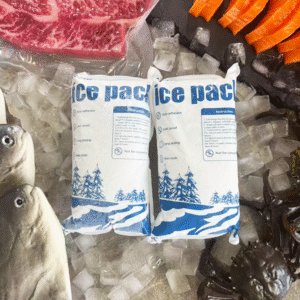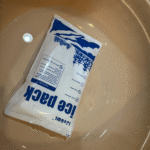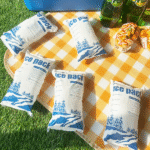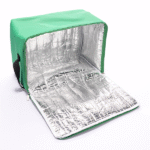Cara mengemas makanan beku dengan es kering dengan benar: A 2025 Memandu
Packing frozen food with dry ice correctly is crucial to ensuring your products stay frozen during transit while also adhering to safety regulations. Dalam panduan ini, you’ll find a step-by-step breakdown of the process, the best packaging materials, dry ice calculations, tindakan pencegahan keselamatan, and how to stay compliant with 2025 peraturan. Keep your shipments in optimal condition and meet all carrier and regulatory requirements.
-
How to calculate the correct amount of dry ice for safe packing
-
Best packaging and insulation methods to prevent sublimation
-
Key labeling rules and compliance steps to avoid costly mistakes
-
Bagaimana 2025 innovations in cold chain technology can make your shipments smarter and greener
How Much Dry Ice Should You Use to Pack Frozen Food?
Jawaban Inti:
Jumlah es kering yang dibutuhkan bergantung pada beberapa faktor: the weight of the product, durasi transit, dan suhu sekitar. A general rule is to plan for 5–10 pon es kering per 24 jam of transit for every 10-15 lbs of frozen food. If the package is poorly insulated or the environment is hotter, Anda mungkin membutuhkan lebih banyak.
Dry Ice Calculation Example
Untuk a 2-transit sehari dengan 5 kg (11 lbs) of frozen food:
Es kering (lbs) = Product Weight (kg) × 1.1 × Transit Days × Safety Buffer
= 5 kg × 1.1 × 2 hari × 1.15 = 12.7 lbs es kering.
Penjelasan & Wawasan:
Sublimat es kering (berubah dari padat menjadi gas), meaning it gradually loses mass over time. The better your insulation and the lower the ambient temperature, the slower the sublimation. Always factor in a safety margin to account for delays or inefficiencies in insulation.
| Berat produk | Waktu transit | Diperlukan Es Kering | Keuntungan |
|---|---|---|---|
| 5 kg | 2 hari -hari | 12.7 lbs | Keeps products frozen with buffer for delay |
| 2 kg | 1 hari | 3–4 pon | Maintains solid freeze even with 8-hour delay |
| 5 kg | 2 hari -hari + penyangga | 14–15 pon | Covers unexpected temperature spikes |
What Packaging and Venting Methods Ensure Safe Shipping?
Jawaban Inti:
For the best dry ice shipping, gunakan a multi-layer insulation system with proper venting. The outer box should be rigid (corrugated or fiberboard), and the inner insulation should consist of Busa EPS (polystyrene yang diperluas) atau VIP (Panel yang diisolasi vakum). Jangan pernah menutup paket dengan kedap udara, as dry ice generates gas, which must escape to avoid pressure buildup.
Venting and Distribution Tips:
-
Ventilasi:
Leave small vent holes (sekitar 5–8 mm) for the CO₂ gas to escape. Ensure the liner is loosely closed but not sealed. -
Penempatan es kering:
Tempatkan es kering di atas dan samping of the frozen food, bukan di bawahnya, to ensure cold air sinks properly and surrounds the product. -
Voids and Space Filling:
Menggunakan busa, kraft paper, or air pillows to fill any gaps inside the package. This reduces airflow and helps keep the temperature stable.
Example in Practice:
A frozen food company optimized its dry ice use by adding extra insulation and repositioning dry ice in perforated bags. They improved the freezing duration by 15% and cut waste by 10%.
What Are the Key Labeling and Documentation Requirements?
Jawaban Cepat:
Untuk pengiriman udara, dry ice must be labeled as “Es kering / Karbon dioksida, Padat (UN1845)” dengan Berat bersih ditandai dengan jelas. Pengiriman berisi lebih dari 5.5 lbs (2.5 kg) of dry ice must also include a Kelas 9 Hazard Diamond. Keep all documentation updated to avoid shipping delays.
Persyaratan Khusus Operator:
-
UPS and FedEx:
Both require notasi waybill (“Es kering, UN1845, Berat bersih”) and proper labeling for hazardous goods. -
IATA and DOT Rules:
Untuk pengiriman internasional, mematuhi Ini pi 954 Dan peraturan DOT. Always double-check the specific limits of each carrier.
Why Proper Labeling Matters:
Incorrect or missing labeling can result in costly fines, penundaan, or even the rejection of your shipment. A Dan 1845 label ensures that your dry ice is handled as a hazardous material according to legal requirements.
What Are the Safety Precautions You Should Take When Handling Dry Ice?
Jawaban Inti:
Dry ice is hazardous due to its extreme cold and the CO₂ gas it releases as it sublimates. Selalu pakai sarung tangan terisolasi, kacamata, Dan protective clothing saat menangani es kering, and ensure the workspace is well-ventilated. Jangan pernah menyegel es kering dalam wadah kedap udara, as the buildup of gas can cause explosions.
Praktik Terbaik Keselamatan:
-
Gunakan APD (Alat Pelindung Diri):
Wear insulated gloves and eye protection at all times when handling dry ice to avoid frostbite or injury from cold exposure. -
Ventilasi:
Ensure all dry ice handling is done in Area yang berventilasi baik untuk menghindari penumpukan CO₂, yang dapat menggantikan oksigen dan menyebabkan sesak napas. -
Pembuangan yang tepat:
Allow dry ice to sublimate in an outdoor area that is well-ventilated. Never dispose of dry ice down drains or seal it in containers.
Contoh dunia nyata:
A food logistics company had a 30% reduction in handling injuries after implementing strict Pelatihan Keselamatan Dan ventilation protocols.
How Do You Handle 2025’s Innovations in Cold Chain Shipping?
Ikhtisar Tren:
As technology advances in 2025, smarter cold chain solutions are emerging. This includes AI-driven coolant dosing, smart packaging systems that track temperature in real-time, Dan eco-friendly liners that help reduce environmental impact.
2025 Inovasi:
-
AI-driven temperature management: Predicts sublimation rates and adjusts dry ice amounts accordingly.
-
Kemasan cerdas: Sensor tertanam melacak suhu, ensuring constant monitoring during transit.
-
Bahan berkelanjutan: Use of isolasi yang dapat terbiodegradasi Dan es kering netral karbon sedang meningkat, reducing waste and carbon footprints.
Wawasan pasar:
With the rise in e-commerce frozen food shipments, customers expect zero-melt pengiriman. Cold chain providers are increasingly adopting these innovations to improve temperature control, Kurangi limbah, dan bertemu tujuan keberlanjutan.
Pertanyaan yang sering diajukan
Q1: How long does dry ice last in transit?
Es kering bisa bertahan 24–72 jam tergantung pada isolasi dan jumlah yang digunakan. Always add extra for buffer time.
Q2: Can I ship dry ice in personal luggage?
Ya, but only up to 2.5 kg (5.5 lbs) with advance approval from the airline. Ensure the bag is vented and properly marked.
Q3: How do I calculate dry ice for my shipment?
Gunakan rumusnya:
Es kering (lbs) = Product weight (lbs) × 1.1 × transit days × 1.15 penyangga pengaman.
Ringkasan dan Rekomendasi
To pack frozen food with dry ice properly, always calculate the right amount of dry ice, choose appropriate packaging, and ensure proper labeling. Untuk 2025, adopting smarter, more sustainable technologies will enhance efficiency and compliance. Keep safety a priority by following best practices for handling and venting dry ice.
Langkah selanjutnya:
-
Review your packing methods and integrate AI-powered or smart packaging for better temperature monitoring.
-
Update your Sops dengan 2025 guidelines and conduct training sessions on dry ice handling.
-
Ensure compliance with all regulations and carrier requirements to avoid delays.
Tentang tempk
Dan Tempk, we specialize in cold chain packaging solutions that reduce dry ice waste by up to 30% while maintaining compliance and performance. Our designs are tailored to meet the stringent requirements of air and ground shipping in 2025. Contact us for a personalized consultation to optimize your shipments.
























